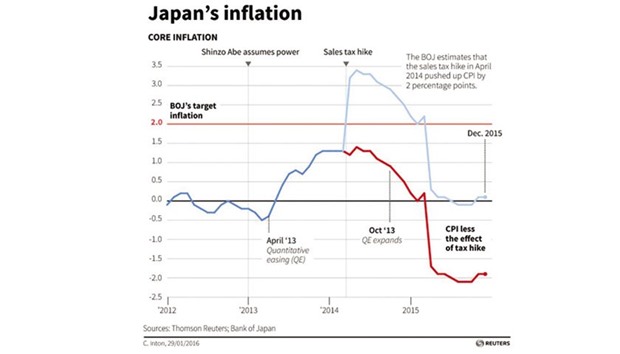The Bank of Japan’s surprise move to adopt negative interest rates won’t contribute much to achieving its 2% inflation goal, according to the majority of analysts polled by Reuters.
The BoJ unexpectedly cut a benchmark interest rate below zero in January, stunning investors with another bold move to stimulate the economy as volatile global markets and low oil prices in particular threaten its efforts to beat deflation.
The central bank’s decision initially sent the yen lower and boosted stocks but the impact quickly evaporated on growing fears about the global economy and the health of the world’s banks.
The dollar has fallen to its lowest against the yen since October 2014 and the Nikkei share average has tumbled to similar levels, while 10-year Japanese government bond yields turned negative for the first time earlier this week.
“I don’t think the BoJ’s negative interest rates will help solve the situation where oil and commodity prices are on the decline globally, which put downward pressure on prices,” said Mari Iwashita, chief market economist at SMBC Friend Securities.
“The BoJ’s decision on negative interest rates at the time of risk-off market spurred worries for the outlook even more.”
Fifteen of 18 analysts in the survey conducted between February 5 and12 said “no” when asked if the BoJ’s quantitative and qualitative easing with negative interest rates increased the likelihood of achieving its 2% inflation goal.
Twelve said the BoJ’s new scheme won’t have a positive effect on the economy, besides possibly helping to weaken the yen and boosting share prices.
“I think the adverse impact from negative interest rates will be bigger than the positive impact on the economy...a negative impact on banks could be big,” said Kazuhiko Ogata, chief economist Japan at Credit Agricole CIB.
“There is a risk that worries about financial system will increase.”
But some believed said the BoJ’s move would help.
Hidenobu Tokuda, senior economist at Mizuho Research Institute, said it was important the BoJ showed its commitment to achieve its 2% inflation target.
“There won’t be much impact from the BOJ’s interest rate reduction this time because it is a small cut but we expect the central bank will lower the rates further, which will have a positive impact to some degree.”
Although all but one analyst who answered a question on the next possible policy action selected “easing further”, they were split on the likely timing.
Two chose the March meeting, six selected April, three each June, July and the October31-November 1 meeting and another picked September. There is no monetary policy meeting scheduled this month.
The BoJ’s policy board decided in a narrow 5-4 vote to charge a 0.1% interest on a portion of current account deposits that financial institutions hold with it.
Asked how far the BoJ could lower negative interest rates, seven of 15 analysts said a range of between -0.2% and -0.5%, six said a range of between -0.6% and -1.0% and two said between
-1.1% and -1.5%.
Inflation, however, is expected to remain tepid.
The core consumer price index, which includes oil products but excludes fresh food prices, will probably average 0.6% in the fiscal year starting April, the poll showed, down from 0.9% projected last month.
In fiscal 2017, prices are expected to rise 1.2% excluding the impact from a planned sales tax hike in April 2017, according to the poll.
At its January meeting, the BoJ postponed the timing to meet its 2% inflation goal to sometime in the first half of fiscal 2017. It was the fourth time the central bank pushed back the timeframe from an initial target of around March 2015.

...


